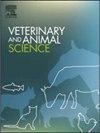使用DTS: Diathermic Syncope®系统,将160-200 kJ的915 MHz微波能量应用于牛的前额,并符合宗教屠宰市场的要求,对组织完整性的影响
IF 1.9
Q2 AGRICULTURE, DAIRY & ANIMAL SCIENCE
引用次数: 0
摘要
虽然社会希望动物在屠宰时得到良好的福利,但在一些宗教要求和现代商业惊人方法之间存在紧张关系。DTS(透热晕厥®)系统的设计旨在缓解这种紧张,通过向前额施加160-200 kJ的915 MHz电磁能量,同时限制对组织的损伤或变化,使动物在0-5秒内失去知觉。为了研究后一个方面,在12只动物身上使用光纤传感器测量了应用点的表面温度;对3只动物应用点皮皮肤进行组织学检查;在能量应用后不久对7个大脑进行检查和触诊;并对四个大脑进行了组织学检查。脑组织未见明显形态学改变,组织学检查也未见明显改变。在施能前8-12秒(最大施能持续时间12秒),施能点的温度与环境温度(29.0-36.5°C)保持接近,然后稳步上升至峰值,并在施能停止时开始下降。最高记录温度为54.27(±6.56)°C,发生在能量应用停止后。虽然本研究中包括的动物数量很少,但它们和使用的过程代表了通过商业屠宰场进行的正常操作。在出血后的尸体上发现的脱毛和前额皮肤的影响可能会因死后的变化而加剧。这些发现可能符合宗教屠杀的要求。本文章由计算机程序翻译,如有差异,请以英文原文为准。
Tissue integrity impacts of application of 160–200 kJ of 915 MHz microwave energy, using the DTS: Diathermic Syncope® system, to the forehead of cattle, and alignment with the requirements of religious slaughter markets
Although society desires good animal welfare at slaughter, there is a tension between some religious requirements and modern commercial stunning methods. The DTS (Diathermic Syncope®) system has been designed with a vision of relieving that tension, rendering the animal unconscious within 0–5 s, by applying 160–200 kJ of 915 MHz electromagnetic energy to the forehead, while limiting damage or changes to the tissues. To investigate this latter aspect, surface temperature at the point of application was measured using fiber optic sensors in 12 animals; application point hide skin of 3 animals was examined histologically; 7 brains were inspected and palpated shortly after energy application; and four brains were examined histologically. There were no gross morphological changes to the brain, and limited evidence of changes on histological examination. Temperatures at the point of application remained close to the ambient (29.0–36.5 °C) prior to and for the first 8–12 s of energy application (max duration of application 12 s), then rose steadily to a peak, and began to fall when energy application ceased. Maximum recorded temperature was 54.27 (± 6.56) °C, which occurred after energy application had ceased. Although small numbers of animals were included in this study, they and the process used were representative of the normal operation through the commercial abattoir. Depilation and effects on forehead skin noted on carcases after bleed-out are likely to be exacerbated by post-mortem change. These findings may comply with religious slaughter requirements.
求助全文
通过发布文献求助,成功后即可免费获取论文全文。
去求助
来源期刊

Veterinary and Animal Science
Veterinary-Veterinary (all)
CiteScore
3.50
自引率
0.00%
发文量
43
审稿时长
47 days
 求助内容:
求助内容: 应助结果提醒方式:
应助结果提醒方式:


